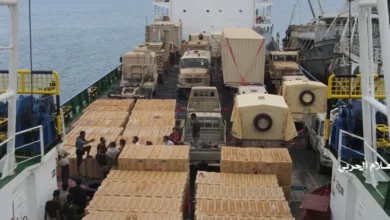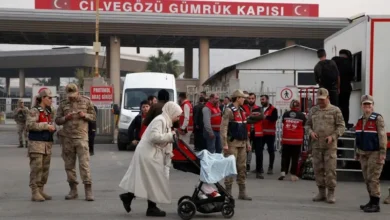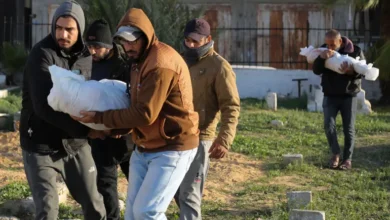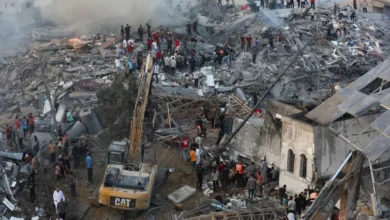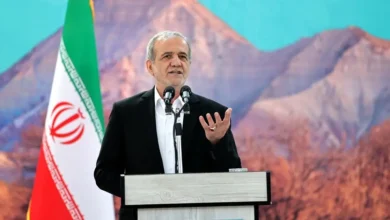Why did Yemen’s Houthis launch attack on Israel, will it help Gaza?

The move by the Iran-linked group, which controls vast swaths of Yemen, comes as Tel Aviv continues to bomb the Gaza Strip, killing more than 10,500 Palestinians, more than 4,300 of them children.
The Yemeni group has launched three rounds of attacks on Israel since the October 7 Hamas attack that killed at least 1,405 Israelis.
So, what have the Houthi attacks – and the response – looked like so far, where does Iran fit in, and where could things go from here?
What has happened so far?
Yahya Saree, a military spokesman for the Houthis, announced on October 31 that the movement launched a “large number” of rockets, ballistic missiles and drones towards Israel.
More strikes would follow “until the Israeli aggression stops” and Palestinians are “victorious”, he said.
None of the projectiles, which were fired at the Red Sea tourist resort of Eilat, are believed to have reached Israel, either having been destroyed by defence systems or falling short.
Israel said it destroyed a drone over the Red Sea. For the first time since the outbreak of the war with Hamas, Israel used its “Arrow” defence system which is designed to take out ballistic missiles outside of the Earth’s atmosphere, according to its military.
On October 27, drones had caused explosions in two Egyptian Red Sea towns, which are located near the Israeli border. Tel Aviv had said at the time that the Houthis had launched drones and missiles intended for Israel.
The United States military had said in late October that a navy warship in the northern Red Sea intercepted projectiles launched by the Houthis, potentially towards Israel.
Is this the ‘new front’ Iran warned about?
As Israeli strikes continue to pound Gaza and kill civilians, Iran has repeatedly warned that if they don’t stop, “new fronts” could be opened in the war by the “resistance axis” – a network of political and armed groups aligned to Iran.
Tehran backs the Houthis in Yemen, Shia armed groups in Iraq, the government of President Bashar al-Assad in Syria, Hezbollah in Lebanon and various Palestinian factions.
Iran, however, has consistently maintained that members of the axis act on their own accord – as Hamas did on October 7.
The Houthi movement, also known as Ansarallah, has been in control of large parts of Yemen, including the capital, Sanaa, since late 2014. For the past nine years, the group has been at war with an internationally recognised Yemeni government that was backed by a military coalition led by Saudi Arabia.
The fighting in Yemen has decreased markedly in recent months as Houthis and Riyadh kicked off peace talks in the wake of Iran and Saudi Arabia restoring diplomatic relations earlier this year.
The Houthis’ entry into the war with Hamas could be concerning for Israel as it is already engaged in border fighting with Hezbollah in southern Lebanon.
Skirmishes between the two have only gradually intensified, and Hezbollah has been increasingly tapping into its secretive arsenal as the two hit deeper into each other’s territories.
Hezbollah chief Hassan Nasrallah did not fully commit the group to the war in a highly anticipated speech on Friday but said that remains a real possibility depending on what Israel and its Western allies do next.
It is unclear whether all the footage released is new. But the footage appeared to show that the Houthis used a variant of their Zolfaghar mid-range ballistic missile, the Quds cruise missile and the Samad drone.
They are all based on similar Iranian models, which are known by different names. There is no reliable information on exactly which variants were used or what their true ranges are, but some of the Houthi projectiles may theoretically have the capability of reaching Israel.
What the Houthis did not use was the purportedly more superior ballistic missile known as the Toofan, which they recently unveiled and has a longer range.
They also possess so-called suicide drones, including one believed to be based on the Shahed 136 Iranian drone, which the West says has been extensively used by Russia in the war in Ukraine despite Tehran maintaining the supply to Moscow was not meant for the war.
So, it appears that the Houthis have yet to fully delve into their varied arsenal of projectiles, which also includes a host of anti-ship missiles.
Thomas Juneau, an associate professor at the University of Ottawa’s Graduate School of Public and International Affairs, told Al Jazeera that the Houthis are unlikely to become full participants in this war, not least of all because they are roughly 2,000 kilometres (1,240 miles) away from Israel.
He said if the conflict escalates into a regional war and Hezbollah and other Iran-backed groups fully join in, the Houthis will most likely keep launching missiles and drones at Israel. But the situation could be different then.




